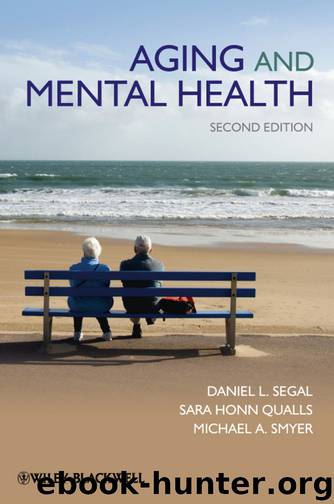Aging and Mental Health by Smyer Michael A. Qualls Sara Honn Segal Daniel L. & Sara Honn Qualls & Michael A. Smyer

Author:Smyer, Michael A., Qualls, Sara Honn, Segal, Daniel L. & Sara Honn Qualls & Michael A. Smyer
Language: eng
Format: epub
Publisher: John Wiley & Sons, Ltd.
Published: 2010-10-04T16:00:00+00:00
Prevention of Depression
We have just provided an overview of treatments for depression in older adults, highlighting the point that several biological and psychological treatments for depression are evidence based, empirically supported, and as such known to be effective for older adults. However, one may wonder: What do we know about the prevention of depression in late life?
Prevention efforts for depression in later life may be aimed at three areas: to avoid a first onset of depression in later life, to prevent the recurrence of depression in older individuals with a prior history of MDD, and to prevent relapse after successful treatment for depression (Fiske et al., 2009). In their review of this topic, Fiske et al. note that targeting older adults who are at high risk for developing depression is an important and effective strategy. For example, treating older adults with subsyndromal levels of depression (before it becomes a full-fledged diagnosable mental disorder – i.e., secondary prevention) could prevent almost 25 percent of new cases in later life. Because insomnia is a known risk factor for depression in later life, treatment for insomnia (discussed in more detail in Chapter 10) may be another avenue to prevent the development of depression in older adults.
Other preventative efforts may also be directed at older adults at risk for depression due to physical illness and its consequences, bereavement, caregiving responsibilities for an ill person, and loneliness (Fiske et al., 2009). Finally, educational efforts directed at physicians, senior service professionals, and older adults in the community to help them recognize the signs and symptoms of depression and understand that depression is not a normal part of aging may also help with early detection and intervention (Fiske et al., 2009).
Download
This site does not store any files on its server. We only index and link to content provided by other sites. Please contact the content providers to delete copyright contents if any and email us, we'll remove relevant links or contents immediately.
Periodization Training for Sports by Tudor Bompa(8170)
Why We Sleep: Unlocking the Power of Sleep and Dreams by Matthew Walker(6618)
Paper Towns by Green John(5091)
The Immortal Life of Henrietta Lacks by Rebecca Skloot(4526)
The Sports Rules Book by Human Kinetics(4294)
Dynamic Alignment Through Imagery by Eric Franklin(4118)
ACSM's Complete Guide to Fitness & Health by ACSM(3989)
Kaplan MCAT Organic Chemistry Review: Created for MCAT 2015 (Kaplan Test Prep) by Kaplan(3940)
Introduction to Kinesiology by Shirl J. Hoffman(3726)
Livewired by David Eagleman(3684)
The Death of the Heart by Elizabeth Bowen(3552)
The River of Consciousness by Oliver Sacks(3541)
Alchemy and Alchemists by C. J. S. Thompson(3451)
Bad Pharma by Ben Goldacre(3357)
Descartes' Error by Antonio Damasio(3230)
The Emperor of All Maladies: A Biography of Cancer by Siddhartha Mukherjee(3068)
The Gene: An Intimate History by Siddhartha Mukherjee(3047)
The Fate of Rome: Climate, Disease, and the End of an Empire (The Princeton History of the Ancient World) by Kyle Harper(3003)
Kaplan MCAT Behavioral Sciences Review: Created for MCAT 2015 (Kaplan Test Prep) by Kaplan(2940)
